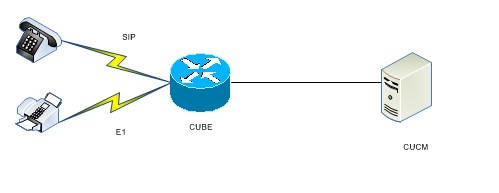- Cisco Community
- Technology and Support
- Collaboration
- IP Telephony and Phones
- SIP & E1 Dial Peers
- Subscribe to RSS Feed
- Mark Topic as New
- Mark Topic as Read
- Float this Topic for Current User
- Bookmark
- Subscribe
- Mute
- Printer Friendly Page
- Mark as New
- Bookmark
- Subscribe
- Mute
- Subscribe to RSS Feed
- Permalink
- Report Inappropriate Content
12-29-2014 06:11 PM - edited 03-17-2019 01:26 AM

I would like some help clarifying Dial peer setup and configuration. Please see setup above. we have a CUBE router which has a E1 that is to be used for faxing (faxes plugged into ATA devices) and SIP trunk to the Telco for all calls.
How would my dial peers look like and how can you configure outbound dial peers to know to use the E1 or SIP to call out???
My thoughts is I need 1 inbound dial peer for all incoming call from the e1 and
dial-peer voice 1 pots
description Direct indial from E1
destination-pattern 0T
direct-inward-dial
port 0/3/0:15
dial-peer voice 2 voip
description Fax outbound to CUCM
destination-pattern 089470.... <-- Fax number range.
dtmf-relay rtp-nte
fax protocol t38 ls-redundancy 0 hs-redundancy 0 fallback none
dial-peer voice 10 voip
description SIP incoming
session protocol sipv2
session target sip-server
incoming called-number .T
voice-class codec 10
no voice-class sip outbound-proxy
dtmf-relay rtp-nte
fax protocol none
dial-peer voice 11 voip
description SIP outgoing to CUCM
destination-pattern 8........ <-- To match any of the many number ranges in the corporation but this might conflict or get matched by the E1 number range.
session protocol sipv2
session target ipv4:10.0.10.1
voice-class codec 10
no voice-class sip outbound-proxy
dtmf-relay rtp-nte
fax protocol none
no vad
Now for calls going out of cucm to the cube to go out to the provider. Is all that configuration in CUCM? what dial peers would we have there?
any assistance would be appreciated.
Solved! Go to Solution.
- Labels:
-
Other IP Telephony
Accepted Solutions
- Mark as New
- Bookmark
- Subscribe
- Mute
- Subscribe to RSS Feed
- Permalink
- Report Inappropriate Content
12-30-2014 01:21 AM
Hi
OK.. here's a few words to get you started.
I'm presuming here that you'll want to control on CUCM where the calls route to - i.e. SIP or E1.
We'll call this option 1:
- In CUCM, you'll add the gateway as a SIP gateway. This gives you a single 'endpoint' to route to, so you need to control calls in another way .
- You would do this by prefixing digits to the called number in CUCM. E.g. user dials 95551234; cucm strips 9 and prefixes 98 to give 98 555 1234.
- 98T is the destination-pattern on a dial-peer (with session target x.x.x.x), so call routes to the target of that peer (e.g. SIP)
- 97T may be the prefix assigned to another dial-peer, which routes calls to E1 (via the port x/x:15 command). So if CUCM prefies 97 (97 555 1234) then it goes out the E1.
- those prefixes might be done based on what the user dials (the user might even dial the prefix) or as part of route list/group configuration so that calls go SIP primarily, and fail over to the E1.
Option 2 - if you just need failover betweeen E1 and SIP
- You can create peers with the same destination-pattern (e.g. 9T) and then fail over between them by setting the 'preference' commmand.
Option 3 - MGCP and SIP
- The gateway could be configured as both a SIP GW and MGCP GW on CUCM. MGCP would be bound to the E1, and SIP as an IP target on a trunk. They are two seperate 'things' from CUCM's point of view, but really the same physical device.
Regards
Aaron
- Mark as New
- Bookmark
- Subscribe
- Mute
- Subscribe to RSS Feed
- Permalink
- Report Inappropriate Content
12-30-2014 01:21 AM
Hi
OK.. here's a few words to get you started.
I'm presuming here that you'll want to control on CUCM where the calls route to - i.e. SIP or E1.
We'll call this option 1:
- In CUCM, you'll add the gateway as a SIP gateway. This gives you a single 'endpoint' to route to, so you need to control calls in another way .
- You would do this by prefixing digits to the called number in CUCM. E.g. user dials 95551234; cucm strips 9 and prefixes 98 to give 98 555 1234.
- 98T is the destination-pattern on a dial-peer (with session target x.x.x.x), so call routes to the target of that peer (e.g. SIP)
- 97T may be the prefix assigned to another dial-peer, which routes calls to E1 (via the port x/x:15 command). So if CUCM prefies 97 (97 555 1234) then it goes out the E1.
- those prefixes might be done based on what the user dials (the user might even dial the prefix) or as part of route list/group configuration so that calls go SIP primarily, and fail over to the E1.
Option 2 - if you just need failover betweeen E1 and SIP
- You can create peers with the same destination-pattern (e.g. 9T) and then fail over between them by setting the 'preference' commmand.
Option 3 - MGCP and SIP
- The gateway could be configured as both a SIP GW and MGCP GW on CUCM. MGCP would be bound to the E1, and SIP as an IP target on a trunk. They are two seperate 'things' from CUCM's point of view, but really the same physical device.
Regards
Aaron
Discover and save your favorite ideas. Come back to expert answers, step-by-step guides, recent topics, and more.
New here? Get started with these tips. How to use Community New member guide